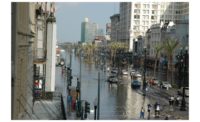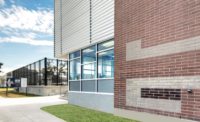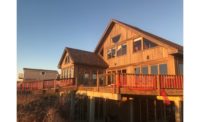By now, homeowners that were flooded have removed carpet, furniture and all of their damaged belongings. The rule of thumb is “when in doubt, throw it out.” Even if floodwaters soaked just the wallboard, it’s best to replace at least four feet above the floor. All the interior gypsum board, insulation and debris found in the wall cavity will need to be hauled away. The American Red Cross suggests that after your home is cleaned out and dry it is time to make a recovery plan. 1 Families will want to make a list of all the work a home will need so that they can be back in as quickly and safely as possible.
So, after a home has been cleaned out and dried—what’s next? How do you rehabilitate a home that becomes too costly to be torn down? The good news is there are a handful of solutions. Houston families that have older masonry homes are now left looking at bare studs and exposed brick. If this is the case, one solution for traditional masonry facades is gaining traction. The two most common strategies to repair these walls are to repair the brick veneer wall system from the outside, or to repair it from the inside.
Repairing the wall system from the outside is an excellent method of ensuring that the house is returned to its original condition, but it can be costly due to the additional labor to remove and relay the brick veneer. Repairing the wall system from the interior is the more cost-effective strategy, and has been used successfully in a variety of areas including preparing homes after hurricane Sandy and Katrina. Although this is the better solution, there are a few critical points to mention.
Replacing the air barrier is the most challenging part, this is currently and most commonly being done with closed cell spray foam, although it can also be done with rigid insulation and sealant. By using the closed cell spray foam, it can air seal in many small and hard to reach areas and ensure a proper bond and compatibility. A second area of concern is replacing the airspace inside the brick. The Brick Industry Association Technical Note Volume 28 requires an airspace in between all brick veneer applications.2 By installing a drainage and ventilation mat in between the flashing and the brick veneer, the mat is now providing a 3/4-inch air space, which can prevent short and long-term moisture issues in wall assemblies.
After the wall cavity has been cleaned out, trapped water removed, and the studs dried with no mold observed, contractors can begin to repair the home from the inside out. What follows are steps to consider.
Drainage Plane Installation
For flood repair, FEMA recommends using materials that can survive wetting and drying, and can be cleaned after a flood to render them free of most harmful pollutants.3 Before starting, make sure all weep holes in the wall are open and cleaned. The first step will be to install the drainage and ventilation mat with its fabric facing inward directly against the interior of the brick veneer. As stated earlier, the mat is engineered to provide a 3/4-inch air space between the brick and the backing to produce a drainage plane that will prevent the transmission of moisture and ensure if any water gets behind the brick it can be channeled down the wall.
Install the mat at the bottom plate; firmly fit the drainage mat between the framing studs. It is important to make sure the bottom piece is tucked into the bottom plate and the top piece is lapped over any exterior sheathing by 6 inches minimum. The mat not only creates the necessary air space behind the brick, but the fabric is resilient to the high heat of the spray foam that will be applied directly to it.
Spray Foam Installation
In Houston, it is important that a contractor apply closed cell foam with this repair method to meet FEMA flood damage material requirements. If a future flood were to happen, the closed cell foam insulation will not absorb or hold water, it will become a vapor barrier to keep moisture out. In addition, since the exterior sheathing is gone, closed cell foam will maintain the wall’s structural integrity by providing racking resistance. First, apply the spray foam vertically up the studs so that it encapsulates the studs and any brick ties (See Photo 1 on page 21). After each side is applied, fill up the remainder of the wall cavity with foam ensuring that the foam is applied past the drainage plane on top.
“We are seeing more families have success with this installation method,” says Gary Cox, Houston resident and employee with Energy Guard Insulation.
“As a homeowner, I get the fact that it’s expensive to rebuild. The good thing with this system is it prevents doing a complete tear down. The Keene HBM mat provides the drainage and recommended air space behind brick while we then spray right on top of it. The foam encapsulates the wall studs and when we fill in the wall cavity, the owner sees an increase in R-value that was not standard in some of these older homes. It’s an efficient system.” (See Photo 2 on page 21.)
After the spray foam has been applied and had time to dry, the final step is to install new drywall. Selecting this approach to Houston flood damage repair will provide a system that will meet the FEMA Flood Damage Resistant Material requirement as well as closely represent the Brick Industry Association’s recommendation for including an airspace behind brick veneer. Whatever system you may choose, play it smart and start with a recovery plan that contains FEMA approved building materials.
1 “Repairing Your Flooded Home.” American Red Cross – FEMA. ARC 4476, FEMA L-198. 1992.
2 “Technical Notes on Brick Construction” Volume 28. The Brick Industry Association. 2012.
3 “Flood Damage – Resistant Materials Requirements” Technical Bulletin 2. FEMA. 2008.









Report Abusive Comment